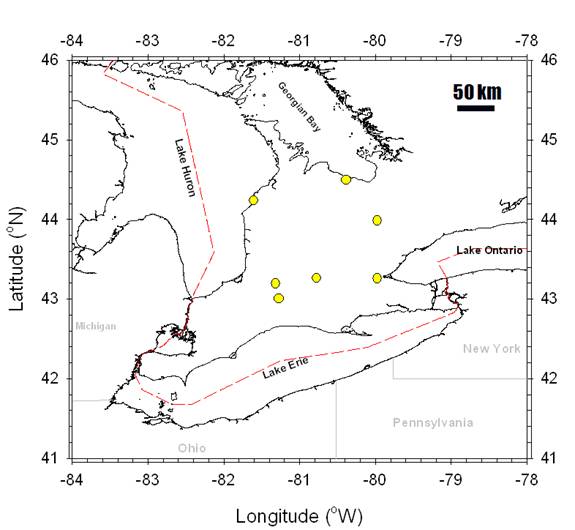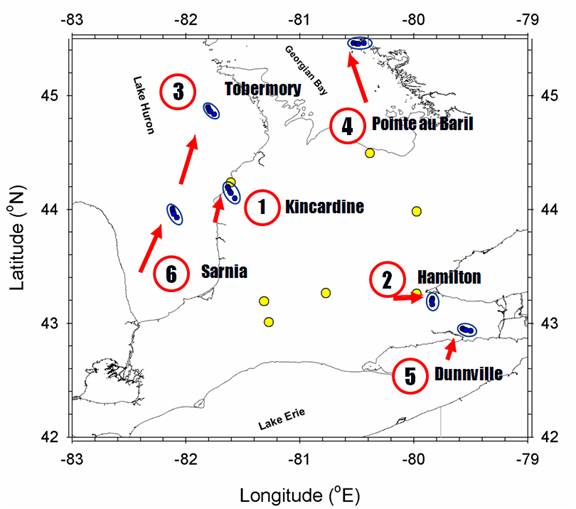The ASGARD All Sky Video Meteor Network
As part of the Western Meteor Group's Southern Ontario Meteor Network sensor suite we have deployed seven all-sky video systems designed to automatically detect bright fireballs. The cameras detect bright meteors as they burn up in the atmosphere. The all-sky video network component of the SOMN was developed originally from hardware and software supplied by Sandia National Labs as part of their sentinel camera network. Our intent was to use a dense array of all-sky cameras (with spacing of order 50-100 km) to record many meteors from multiple stations. The intent is to use the moderate precision metric data for comparison with other instrumental recordings of the same event and to act as a "trigger" for other instruments in the SOMN. Here we sacrifice precision in favour of semi-automation in reduction. The distirbution of cameras (yellow circles) in the network is shown below.

ASGARD Detection Software
To record fireballs with these video systems, the All Sky and Guided Automatic Real-time Detection (ASGARD) software was developed by one of us (R. Weryk). An early version of the detection software and our reduction procedures was first described by Weryk et al. (2008). The software detects meteors in real-time, and can acquire video data from a range of video sources, including analog video camera interfaces, pre-recorded video, and digital camera interfaces using the high-speed CameraLink interface. The software is run under the Debian GNU/Linux operating system, and ideally requires at least a 1 GHz processor, 256 MB of memory, and a 40 GB hard drive. However, a modern 3 GHz processor could run 8+ cameras simultaneously. This would be beneficial if each camera had a longer focal length lens, which would give effective all-sky coverage while at the same time being sensitive to fainter meteors.
The Hardware
The cameras used for each station are HiCam HB-710E SONY Ex-view HAD (1/2" size) CCD cameras equipped with a Rainbow L163VDC4 1.6-3.4 mm f/1.4 lens . The cameras are housed inside a simple enclosure with a clear acrylic dome (see picture below). The enclosure has a thermostat for heating during winter and a fan system to circulate air and prevent dewing of lenses or the dome. A photosensor attached to each camera which shuts off the unit during the day. The acrylic domes have a useful lifetime of only ~6 months and are entirely replaced on a regular basis. The video signal from the camera (NTSC, 29.97 frames per second) in a 640x480 format is captured by a Brooktree 878A frame-grabber card in a PC, processed, and then streamed to disk. Timing information (based on the system time when a hardware interrupt from the capture card occurs) is calibrated against a US GlobalSat BU-353 USB GPS receiver using the Network Time Protocol (NTP) software. Instead of simply correcting the system clock periodically (which allows it to drift between updates), NTP will adjust the clock rate to ensure the clock is always accurate to better than one frame time. When extreme accuracy is desired, NTP can use a pulse per second (PPS) signal to obtain times accurate to ~10 microseconds.

A schematic of the multi-camera detection and processing flow is show below

Each automatically detected event has a preliminary solution generated for quick-review. The final trajectory and photometry for positively identified meteor events is performed manually to ensure quality. An example of the quick-look automatically generated review is shown below:

Here the apparent paths on the all sky image from each camera is graphically displayed (upper left plot) and a plot of the expected length as a function of time - observed length (Trail offset) is given in the upper right corner - this allows for quick checks as to whether deceleration is evident of not. The lower two plots show the apparent path of the meteor on a local map of Southern Ontario and the final plot shows the apparent orbit of the body.
The apparent magnitude distribution of all manually reduced multi-station events is shown below:

In total we have recorded just over 2000 multi-station events since the network became operational in 2006.
While the main purpose of the network is to provide co-ordinated observations with other sensors (radar, infrasound, seismic etc.) the network has recorded a number of possible meteorite dropping fireballs. One recovered event occurred on Sept 25, 2009 and dropped meteorites near Grimsby, ON. Other possible meteorite producing events are shown below:

Additional Details about the system can be found here.,



